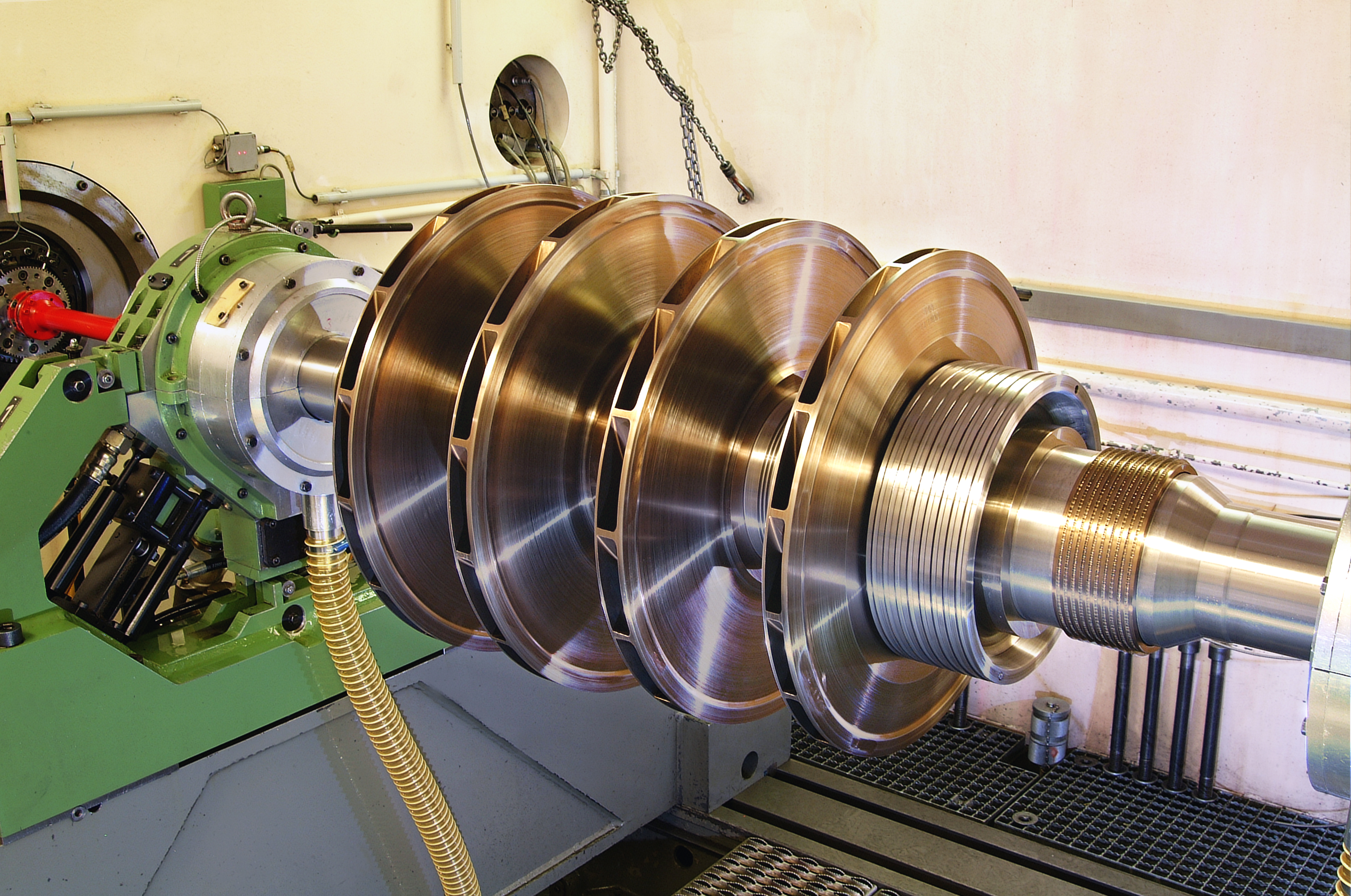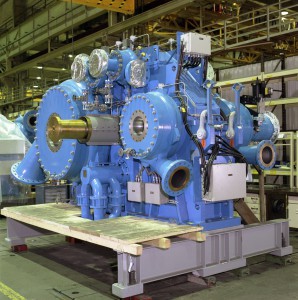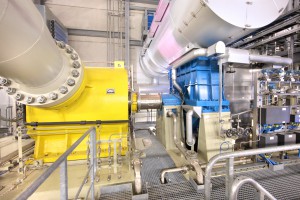September 2013, Vol. 240 No. 9
Features
How To Put Pressure On The Pipe

Oil and gas exploration is much about its transportation, and compressors play a central role in the pertinent processes. This overview of the diverse technology driving the industry cites the example of German MAN Diesel & Turbo’s broad turbomachinery product range.
It is quite a long way to go for oil and gas, starting at the borehole to finally become a petrochemical product. Pressure is the magic word to achieve that, as it is the only possibility of forcing fluids or gases to move through pipes or tubes. Today, various types of turbomachinery are applied in the diverse areas of the oil and gas industry. Compressors and turbines are used for upstream (production), midstream (transportation) and downstream (processing) applications.
German-based company MAN Diesel & Turbo’s turbomachinery can be applied to practically every industrial gas processing or production process.
MAN Diesel & Turbo compressors, expanders and turbines of various designs are applied in crude oil and gas production processes, such as gas lift and gas injection, gas gathering, gas treatment and processing of the raw gas or oil (to LPG or LNG) for transportation. These applications create high demand for turbomachinery with respect to temperature and volume of the medium.

The commonly applied base-type is the centrifugal compressor. Within these compressors, there are two main designs: the barrel type (RB) and the horizontally split type (RH), which describes the layout of their casings. While an RH-casing consists of two parts with a horizontal split, the barrel-type casing is looks like a cask. Its interior parts are plugged in from the side and are enclosed by two end plates, thus reducing the seal face and allowing it to operate with significantly higher pressures.
RH-type centrifugal compressors from MAN Diesel & Turbo allow suction flow rates up to 660,000 m3 per hour with maximum discharge pressures of 80 bar. Suction flow rates of RB-types can reach 230,000 m3 per hour, while maximum discharge pressures of 1,000 bar are possible.
The working principle stays the same, regardless: the gas is sucked in at the front by rotation of the impeller. The blades of the impeller force the gas outward from the center to the tips. The increased velocity of the gas creates a flow pressure at the eye of the impeller. The gas at the outer rim of the impeller is forced into a passage way, the diffuser, where the velocity decreases in the pressure of the gas. The compressors can be built featuring multi-stages of these impellers.
Compressor stations are critically important to the transportation of natural gas over long distances. MAN Diesel & Turbo offers both conventional pipeline compressors and hermetically sealed compact compressors with integrated high-speed motor and magnetic bearings (MOPICO®) to fulfill the specific requirements in pipeline compressor stations.

The first MAN Diesel & Turbo pipeline compressor was supplied more than 40 years ago. Today, these compressors have proved their availability and reliability in millions of operating hours worldwide. Continuous product developments, tailored design features and a broad operating range are only a few examples of their characteristics. These machines are API and NACE compliant. They can generate discharge pressures up to 130 bar and handle a maximum power input of 30 MW. Its typical drivers are gas turbines or electrical motors.
The MOPICO® gas pipeline compression system is a state-of-the-art, integrated motor-driven pipeline compression system. The simple, compact and cost-effective design concept results in a reliable and largely maintenance-free system with high efficiencies over the complete operating range. It is an emission-free, environmentally neutral system, which has minimum service requirements. This makes it well-suitable for remote control and unmanned operation.
The technology at work is called HOFIM, short for “high-speed, oil-free compression system.” In 1990, MAN Diesel & Turbo pioneered the first HOFIMTM compressor by eliminating components such as dry gas seals, the lube oil system and the gearbox. The HOFIMTM compressor package features the use of high-speed induction motor. This driver is cooled by process gas and directly coupled to the barrel-type compressor.

The demand for these special compressors within the oil and gas industry is growing steadily. Regarding power generation and the demand for production purposes, it will not be possible to meet the needs of the global population by using renewable sources alone. New reserves of oil and gas must be located and developed on an ongoing basis. Since easily accessible sources, such as those in the oil-rich desert countries of the Middle East, are becoming increasingly scarce, the exploration and extraction of these natural resources is becoming ever more demanding. In order to meet global requirements, experts are advancing into increasingly remote, poorly accessible regions.
Wells on the seabed are an example. An operation that was previously undertaken from platforms on the ocean’s surface is now descending into the depths. Machinery and equipment are installed directly on the seabed, bringing the precious resources through pipes to the surface under automatic control and monitoring. From that point, they are carried by pipeline or tanker to the consumer markets.
MAN Diesel & Turbo has developed the world’s first subsea compressor for Norwegian energy company Statoil, allowing natural gas to be extracted directly from the seabed. In this demanding task, the virtually maintenance-free compressor withstands the water pressure at considerable depth, thanks to its robust, hermetically-sealed casing, which also prevents gas from escaping. This makes subsea production more cost-effective and more reliable while the risk posed by negative environmental influences can also be further reduced.
The general demand for greener technologies within the oil and gas industry also leads to new compressor applications. For instance, carbon capture and storage (CCS) is an area in which MAN Diesel & Turbo is providing solutions. Shell Canada just ordered compressor technology for an oil sands operation in Alberta, Canada. The Quest project will be a commercial-scale implementation of CCS into a bitumen upgrader to tackle carbon emissions. It will capture more than a million tons of this greenhouse gas per year and store it deep underground at an injection site north of the facility.
![]()
MAN Diesel & Turbo will deliver a RG-type integrally geared centrifugal compressor this year for Quest. The advantage of this kind of machinery is that individual process stages can be controlled within one casing. This allows cost and space-efficient operation as only one external driver with constant revolution is necessary. In addition to other applications, the German manufacturer has optimized its integrally geared compressors for CO-2 compression.
In the case of Quest, four pinions are engaged with different gear ratios, thus leading to diverse rotating speeds. Each pinion mounts two impellers in a back-to-back arrangement. They compress the CO-2 in eight stages to a discharge pressure of 130 bar. This integrally geared centrifugal compressor handles 80,000 cubic meters of CO-2 per hour. It will be constructed of familiar components, which have proved reliable in different frame sizes over many years.
The discharge pressure of 130 bar is sufficient to send the compressed CO-2 about 60 kilometers via an underground pipeline to a wellhead, as well as injecting the dense phase CO-2 2.3 kilometers below the surface into a saline rock formation for permanent storage.
When the amount of oil in a field has decreased to a level at which no more can be recovered with conventional extraction methods like water injection, CO-2 flooding can be effective. CO-2 and oil mix above a pressure known as the minimum miscibility pressure (MMP). At or above the MMP, CO-2 acts as a solvent, cleanly sweeping the reservoir, leaving only very little residue behind. At pressures below the MMP, carbon dioxide also assists oil production by swelling the oil and reducing its viscosity. This technique can be used in natural gas fields to recover additional gas from exploited fields.
In some cases, very robust compressor technology is required. The process-gas screw compressor series from MAN Diesel & Turbo is designed to handle highly contaminated gases (e.g. dust or droplets) and other gas mixtures under heavy-duty conditions that would curtail the availability and life expectancy of other compressor types. The screw compressor is operating as a positive displacement machine, combining the advantages of reciprocating or centrifugal types. For example, Brazilian energy company Petrobras has recently ordered six two-stage screw compressor units for six offshore oil production installations, known as FPSO (floating production, storage and offloading) units being created about 300 kilometers southeast of São Paulo in the Santos Basin of the Atlantic Ocean.
Each package compresses oil-associated gas in two stages to prepare it to be later on in the process fed back into the borehole. With the aid of MAN technology, Petrobras avoids unnecessary emissions of CO-2, which in the past resulted from the flaring of oil-associated gases over the boreholes. Consequently, screw compressors from MAN Diesel & Turbo are moving into areas of application and pressure ranges that have formerly been dominated by reciprocating and other compressor types.
Last but not least, MAN Diesel & Turbo can offer its own drivers for many compressor types. Gas turbines are installed in pipeline stations for various oil and gas transport applications in many countries around the world, including the United States, Algeria, Bulgaria, Germany, France, Mexico, Nigeria, and Russia. The combination of a gas turbine driving a pipeline compressor is the perfect arrangement in a natural gas pipeline network.
These compressor stations are able to work independently from any infrastructure as the compressor’s process gas is the gas turbine’s fuel at the same time. Moreover, it is the best choice out of several gas and steam turbines or electric motors that drives compressors in onshore and offshore applications within the oil and gas production.
MAN Diesel & Turbo SE, based in Augsburg, Germany, provides large-bore diesel engines and turbomachinery for marine and stationary applications. It designs two-stroke and four-stroke engines that are manufactured both by the company and by its licensees.





Comments